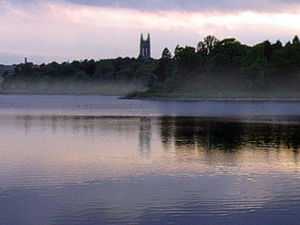Chestnut Hill Reservoir
| Chestnut Hill Reservoir | |
|---|---|
 View of Boston College from across the reservoir | |
| Location | Boston, Massachusetts |
| Coordinates | 42°20′6.30″N 71°9′30.52″W / 42.3350833°N 71.1584778°WCoordinates: 42°20′6.30″N 71°9′30.52″W / 42.3350833°N 71.1584778°W |
| Type | reservoir |
| Basin countries | United States |
Chestnut Hill Reservoir is a reservoir created in 1870 on existing marshes and meadowland to supplement the city of Boston's water needs. It is surrounded by Chestnut Hill, a neighborhood which consists of parts of Boston, Brookline, and Newton. The reservoir, though, is located entirely within the city limits of Boston.[1] A 1.56 mile[2] jogging loop abuts the reservoir. Chestnut Hill Reservoir was taken offline in 1978 as it was no longer needed for regular water supply distribution,[3] but is maintained in emergency backup status.[4][5] It is recognized today on the National Register of Historic Places and it has designation as a City of Boston Landmark.
On May 1, 2010, the Chestnut Hill Reservoir was temporarily brought back online during a failure of a connecting pipe at the end of the MetroWest Water Supply Tunnel. The Sudbury aqueduct was also activated to feed Chestnut Hill from the Foss and Sudbury reservoirs to keep the supply going. Separately the Spot Pond reservoir, also an emergency source, was tapped during the pipe break incident. Though a boil-water order was issued for fear that the water would not be safe to drink, following heavy treatment with chlorine later tests showed the water to be completely safe for drinking. [6][7]
In mid April 2012, the body of a Boston College student who had been missing for seven weeks was found in the reservoir.[8] Initial autopsy results were consistent with the student having accidentally drowned.
Transportation
- Chestnut Hill, Green Line (MBTA)
See also
References
- ↑ AAA Map of Boston including Arlington, etc., 2007, Heathrow, Florida: AAA
- ↑ Water For Greater Boston Brighton Allston Historical Society. See paragraph 9.
- ↑ "MWRA history". Retrieved 2012-06-16.
- ↑ Massachusetts Water Resources Authority (May 4, 2009). "Water Supply and Demand". Retrieved 2009-08-16.
- ↑ Massachusetts Water Resources Authority (August 9, 2006). "Water System History". Retrieved 2009-08-16.
Completion to the Dorchester Tunnel in 1978 allowed the demands of the southern systems to be removed from the Sudbury Aqueduct. However, because there is no redundancy for the Dorchester Tunnel, the facilities taken off line in 1978 must remain in stand-by status.
- ↑ Daley, Beth; Gil, Gideon (May 5, 2010). "Tests confirm it — water was OK to drink all weekend". The Boston Globe.
- ↑ http://www.wbur.org/2010/05/03/laskey-debrief
- ↑ http://bostonherald.com/news/regional/view/20220411report_of_body_found_in_chestnut_hill_reservoir